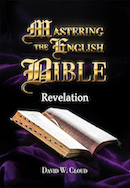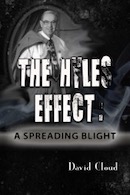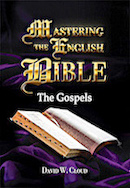866-295-4143, fbns@wayoflife.org

What could be more mystical than touching God with your hands and taking Him into your very being by eating him in the form of a wafer? In the Mass the strangely-clothed, mysterious priest (ordained after the order of Melchisedec) pronounces words that mystically turn a wafer of unleavened bread into the very body of Jesus. The consecrated wafer, called a host (meaning victim) is eaten by the people.
On some occasions one larger host is placed in a gaudy metal holder called a monstrance to be worshipped (“adored”) as God. This is called Eucharistic adoration.
Eventually the host is placed in its own little tabernacle as the focus of worship between Masses. A lamp or a candle is lit to signify the fact that the consecrated host is present.
This highly mystical ritual is multisensory, involving touch (dipping the finger into holy water and touching the wafer), sight (the splendor of the church, the priestly garments, the instruments of the Mass), smell (incense), hearing (reading, chanting, bells), and taste (eating the wafer).
The Mass is even said to bring the participant into “divine union” like other forms of contemplative mysticism (Thomas à Kempis, The Imitation of Christ, book IV, chap. 15, 4, p. 210).
The Second Vatican Council reaffirmed the centrality of the Mass in Catholic life:
“The celebration of the Mass ... is the centre of the whole Christian life for the universal Church, the local Church and for each and every one of the faithful. For therein is the culminating action whereby God sanctifies the world in Christ and men worship the Father as they adore him through Christ the Son of God” (Vatican Council II: The Conciliar and Post Conciliar Documents, edited by Austin Flannery, 1975, “The Constitution on the Sacred Liturgy, General Instruction on the Roman Missal,” chap. 1, 1, p. 159).
The Catholic Mass is not a mere remembrance of Christ’s death; it is a re-sacrifice of Christ, and the consecrated host IS Christ. Consider statements from the authoritative Council of Trent, Second Vatican Council, and the New Catholic Catechism.
“There is, therefore, no room for doubt that all the faithful of Christ may, in accordance with a custom always received in the Catholic Church, give to this most holy sacrament in veneration the worship of latria, which is due to the true God” (The Canons and Decrees of the Council of Trent, translated by H. J. Schroeder, chap. v, “The Worship and Veneration to be Shown to This Most Holy Sacrament,” p. 76).
“The victim is one and the same: the same now offers through the ministry of priests, who then offered himself on the cross; only the manner of offering is different. And since in this divine sacrifice which is celebrated in the Mass, the same Christ who offered himself once in a bloody manner on the altar of the cross is contained and offered in an unbloody manner... this sacrifice is truly propitiatory” (Council of Trent, Doctrina de ss. Missae sacrificio, c. 2, quoted in Catechism of the Catholic Church, 1367).
“For in the sacrifice of the Mass Our Lord is immolated when ‘he begins to be present sacramentally as the spiritual food of the faithful under the appearances of bread and wine.’ … For in it Christ perpetuates in an unbloody manner the sacrifice offered on the cross, offering himself to the Father for the world’s salvation through the ministry of priests” (Vatican Council II: The Conciliar and Post Conciliar Documents, “The Constitution on the Sacred Liturgy,” Instruction on the Worship of the Eucharistic Mystery, Introduction, C 1,2, p. 108).
“The faithful should therefore strive to worship Christ our Lord in the Blessed Sacrament. ... Pastors [priests] should exhort them to this, and set them a good example. ... The place in a church or oratory where the Blessed Sacrament is reserved in the tabernacle should be truly prominent. It ought to be suitable for private prayer so that the faithful may easily and fruitfully, by private devotion also, continue to honour our Lord in this sacrament” (Vatican Council II: The Conciliar and Post Conciliar Documents, “The Constitution on the Sacred Liturgy,” Instruction on the Worship of the Eucharistic Mystery, Chap. 3, I B, p. 132).
“By the consecration the transubstantiation of the bread and wine into the Body and Blood of Christ is brought about. Under the consecrated species of bread and wine Christ himself, living and glorious, is present in a true, real and substantial manner: his Body and his Blood, with his soul and his divinity” (New Catholic Catechism, 1314).
“Because Christ himself is present in the sacrament of the altar he is to be honoured with the worship of adoration” (New Catholic Catechism, 1418).
“The sacrifice of Christ and the sacrifice of the Eucharist are one single sacrifice ... ‘In this divine sacrifice which is celebrated in the Mass, the same Christ who offered himself once in a bloody manner on the altar of the cross is contained and offered in an unbloody manner’” (New Catholic Catechism, 1367)
“In the liturgy of the Mass we express our faith in the real presence of Christ under the species of bread and wine by, among other ways, genuflecting or bowing deeply as a sign of adoration of the Lord. ... reserving the consecrated hosts with the utmost care, exposing them to the solemn veneration of the faithful, and carrying them in procession” (New Catholic Catechism, 1378).
The consecrated host is therefore worshipped as Christ.
It is obvious that the Mass is not a Scriptural practice. The apostle Paul, under divine inspiration, taught the churches the significance of the Lord’s Supper (1 Corinthians 11:17-34), and he did not say that it is a repetition of Christ’s sacrifice. It is not Christ becoming a piece of bread. It is not an occasion to eat Christ or partake of him “sacramentally.” It is a simple memorial meal, a time of remembrance and confession and worship.
“For I have received of the Lord that which also I delivered unto you, That the Lord Jesus the same night in which he was betrayed took bread: And when he had given thanks, he brake it, and said, Take, eat: this is my body, which is broken for you: this do IN REMEMBRANCE OF me. After the same manner also he took the cup, when he had supped, saying, This cup is the new testament in my blood: this do ye, as oft as ye drink it, IN REMEMBRANCE OF me” (1 Corinthians 11:23-25).
Paul said that he received this teaching directly from the Lord. It is authoritative. He is the divinely-chosen apostle of the Gentiles, and he praised the churches for keeping the ordinances as he delivered them (1 Corinthians 11:2).
Speaking for all of the Catholic nuns and priests that are quoted by Richard Foster and others in the contemplative movement, Mother Teresa said that her Jesus is the consecrated wafer of the Mass. In her speech at the Worldwide Retreat for Priests, October 1984, in the Paul VI Audience Hall at Vatican City, she made the following statements:
“At the word of a priest, THAT LITTLE PIECE OF BREAD BECOMES THE BODY OF CHRIST, the Bread of Life. Then you give this living Bread to us, so that we too might live and become holy” (Mother Teresa, cited in Be Holy: God’s First Call to Priests Today, edited by Tom Forrest, 1987, p. 108).
“I remember the time a few years back, when the president of Yeman asked us to send some of our sisters to his country. I told him that this was difficult because for so many years no chapel was allowed in Yemen for saying a public mass, and no one was allowed to function there publicly as a priest. I explained that I wanted to give them sisters, but the trouble was that, without a priest, without Jesus going with them, our sisters couldn’t go anywhere. It seems that the president of Yemen had some kind of a consultation, and the answer that came back to us was, ‘Yes, you can send a priest with the sisters!’ I was so struck with the thought that ONLY WHEN THE PRIEST IS THERE CAN WE HAVE OUR ALTAR AND OUR TABERNACLE AND OUR JESUS. ONLY THE PRIEST CAN PUT JESUS THERE FOR US. ... Jesus wants to go there, but we cannot bring him unless you first give him to us” (Mother Teresa, Be Holy, pp. 109, 111).
“One day she [a girl working in Calcutta] came, putting her arms around me, and saying, ‘I have found Jesus.’ ... ‘And just what were you doing when you found him?’ I asked. She answered that after 15 years she had finally gone to confession, and received Holy Communion from the hands of a priest. Her face was changed, and she was smiling. She was a different person because THAT PRIEST HAD GIVEN HER JESUS” (Mother Teresa, Be Holy, p. 74).
Some Catholics have charged me with misrepresenting their church, but surely the Second Vatican Council and the New Catholic Catechism and Mother Teresa are authentic voices. Mother Teresa plainly stated that her Jesus was the wafer of the Mass.
In the 1990s I visited a cloistered nunnery in Quebec. A pastor friend took me with him when he visited his aunt who had lived there for many decades. He and his wife wanted to show the nun their new baby. She wasn’t allowed to come out into the meeting room to see us; she had to stay behind a metal grill and talk to us from there. The nuns pray in shifts before the consecrated host in the chapel. That is their Jesus and the object of their prayers. At the entrance of the chapel there was a sign that said, “YOU ARE ENTERING TO ADORE THE JESUS-HOST.” Nuns were sitting in the chapel facing the host and praying their rosaries and saying their prayers to Mary and their “Our Fathers” and other repetitious mantras, vainly and sadly whiling away their lives in ascetic apostasy.
In the next chapter we will see that the Catholic saints, who are so exalted today by contemplatives, worshipped the Jesus-host of the Mass.
Many modern converts to Romanism mention the role that the Mass played in their conversion. There is doubtless a true occultic power in this ritual.
The following is the testimony of Marie-Ange Desrosiers of Quebec in which she describes the powerful occultic experience that she had at a Catholic mass following her conversion to the grace of Jesus Christ. She gave this testimony to me in an e-mail dated November 15, 2008, and I am using it with her permission.
“I was raised in a very rigid catholic religion in the 1940-1950 and I learned only about a God of wrath. At the age of twenty, I quit the Catholic Church because I was unable to observe all their laws. For the next 25 years, I forgot about God. But God never forgot me. Through a long, circuitous and painful road, he led me back to Him, the real God. I am a recent convert to the Baptist faith. I was baptized in September and will now be part of a very small French Baptist church in Canada. What I want to tell you is about your writings on mysticism. You can take the girl out of the Catholic Church, but it is very hard to take the church out of the girl. Until I started reading your books, I never really re-examined what I was taught with my mother’s milk. I did not like the Catholic Church but I could not tell you what was wrong with it. To make a long story short, on August the 9th, 2008, I went to a family wedding in a catholic church. Of course, I remained in my pew and did not partake of Communion because I do not believe in it. But the emotional fervor around me was so strong as to become palpable. And all of a sudden, I was enveloped in a warm sort of embrace that was so powerful and so marvelously pleasant that I was amazed. What is happening? I thought. It got stronger and stronger, and more and more physically enjoyable. My hands, feet, mouth, my whole face started to tingle very pleasurably. I was immensely drawn into that warm, loving, physical feeling. Then I heard myself whisper: Too bad it is not true, it is so pleasant. And then, I came back forcefully to myself and said NO! NO! And the thing left me. I did not know what it was but I had a strong feeling it was wrong. Since then, I happened to read a book by Roger Oakland, ‘The Eucharistic Jesus,’ where he speaks quite clearly of the end-times delusion of experiential spirituality mentioned in the Bible. And even after it left me, I could feel and almost see that thing around other people in the church who had swallowed their ‘wafer god.’ It is going to be very hard for people who undergo this experience repeatedly to believe it does not come from God. And only the Holy Spirit protecting me allowed me to refuse it. The Lord has protected me all my life, even when I did not belong to Him yet. But my poor, poor family. How I weep for them! And I pray daily that the Lord opens their mind and their heart to His word. But this ‘thing’ is so, so seducing. It will take a mighty wind of the Lord to tear it away from my family. By the way, the Catholic Church calls it an anointing of the Lord. I call it the embrace of Satan. Pray for us, please, I will also pray for you.”
The Mass is a mystical powerhouse.
- Receive these reports by email
- www.wayoflife.org
______________________
Sharing Policy: Much of our material is available for free, such as the hundreds of articles at the Way of Life web site. Other items we sell to help fund our expensive literature and foreign church planting ministries. Way of Life's content falls into two categories: sharable and non-sharable. Things that we encourage you to share include the audio sermons, O Timothy magazine, FBIS articles, and the free eVideos and free eBooks. You are welcome to make copies of these at your own expense and share them with friends and family. You may also post parts of reports and/or entire reports to websites, blogs, etc as long as you give proper credit (citation). A link to the original report is very much appreciated as the reports are frequently updated and/or expanded. Things we do not want copied and distributed are "Store" items like the Fundamental Baptist Digital Library, print editions of our books, electronic editions of the books that we sell, the videos that we sell, etc. The items have taken years to produce at enormous expense in time and money, and we use the income from sales to help fund the ministry. We trust that your Christian honesty will preserve the integrity of this policy. "For the scripture saith, Thou shalt not muzzle the ox that treadeth out the corn. And, The labourer is worthy of his reward" (1 Timothy 5:18). Questions? support@wayoflife.org
Goal:Distributed by Way of Life Literature Inc., the Fundamental Baptist Information Service is an e-mail posting for Bible-believing Christians. Established in 1974, Way of Life Literature is a fundamental Baptist preaching and publishing ministry based in Bethel Baptist Church, London, Ontario, of which Wilbert Unger is the founding Pastor. Brother Cloud lives in South Asia where he has been a church planting missionary since 1979. Our primary goal with the FBIS is to provide material to assist preachers in the edification and protection of the churches.
Offering: Offerings are welcome if you care to make one. If you have been helped and/or blessed by our material offerings can be mailed or made online with with Visa, Mastercard, Discover, or Paypal. For information see: www.wayoflife.org/about/makeanoffering.html.








